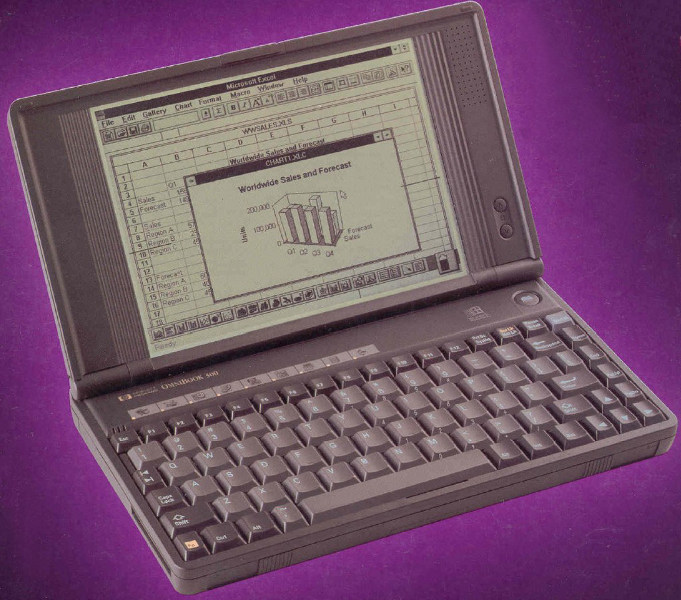Hewlett Packard Omnibook 300 Details and specs
Hewlett Packard Omnibook 300 (OB300)

About this machine:
The Hewlett Packard Omnibook 300 is the first of the long lasting Omnibook series. Definitely larger than a palmtop, but one of the earliest and best subnotebooks. The design is definitely a pun on the LX series - all the early omnibooks look like an oversized LX. I usually have a hard time adding subnotebooks to this list, but the fact that the OB300 and its successors can use AA-Batteries changed my mind. These are actually very well made subnotebooks with a pretty solid high quality case and some neat features. What catches up the spirit of the LX series is definitely the palmtop-alike "Instant on" feature, so turning off the computer just puts it on kinda standby mode which barely consumes any battery but lets you continue where you left off once you switch it on again. ANother typical palmtop feature is the software in the ROM. Well here HP was a bit unique by putting it on a "ROM Card" which is kinda PCMCIA write protected flash card. I guess they intended to offer software updates for these (But they never did). Another nice feature is the unique retractable mouse "on a stick". It's hard to describe, but the tiny mouse that pops out from the right side on the push of a button is connected to the laptop via some kinda stick, so you can even use it in the air (No mouse pad required). The ROM contains DOS 5.0, Windows 3.1, WinWord and Excel. Along with the pretty good monochrome VGA screen it is a remarkably good Windows 3.1 subnotebook. Unfortunately the System ROM checks the System on startup, so if you try to install a different OS it will halt the boot process and ask you to reformat the boot disc. So expect to be stuck with DOS 5.0 even though in theory it could load something else.
Specs:
CPU: Intel 386SXLV @ 20 MHz
Graphics: Monochrome VGA
Display: 640 x 480 monochrome STN , 16 grey scales, 9 inch
Memory (RAM): 2 MB (Can be extended up to 8MB with proprietary RAM extensions)
ROM (Software): 4 MB
I/O ports: RS232 Serial , 4 x PCMCIA 2.0 Type 2 slot (1 slot lost due to necessary ROM card), Infrared (115K bi-directional), Parallel port
Sound: PC Speaker - Piezo
Operating System: MS-DOS 5.0, Windows 3.1
Software: Word for Windows 2.0c, Excel 4.0, Typical Windows 3.1 tools, Phone Book, Appointment, File Transfer tools, HP calculator
Size: Length 28.2cm, Width 16.3cm, Height 3.6cm (11.1 inches x 6.4 inches x 1.4 inch)
Powered by: 4 AA batteries non-rechargable or Battery Pack or AC adaptor
Weight: 1310 gram including battery pack and Flash card
Special features: Parallel port, infrared, VGA display, Modem (optional module).
Released: June, 1993
Originally retailed for:: 1,515 USD (No mass storage) / 1,950 USD (40MB PCMCIA Type III HDD) / 2,375 USD (10 MB Flash card)
Clone of: Not a clone.
Similar models: HP Omnibook 425, HP Omnibook 430
Pros:
- Excellent for easy printing on JetEye compatible HP printers
- Contains Word and Excel
- Windows 3.1 offers quite a lot of Software
- PCMCIA 2.0 Type 2 (III) slot: Can use virtually any PCMCIA card (For Windows 3.1)
- Fully VGA compliant, so most VGA games will work (Unless they require 256 colors or more)
Cons:
- Large and heavy
- Battery life rather weak
- Will not let you install another OS
Collector Value:
5 of 10
Usage Value:
3 of 10
Verdict:
Give it a usability value of 10/10 if you love large and heavy subnotebooks. This is ridiculously heavy and large compared to Palmtops. Anyways if you can cope with the size, weight and weak battery life then you at least get a reliable Windows 3.1 laptop with VGA. One of the few notebooks that will let you use AA-Batteries.
Back to the Palmtop PC index
